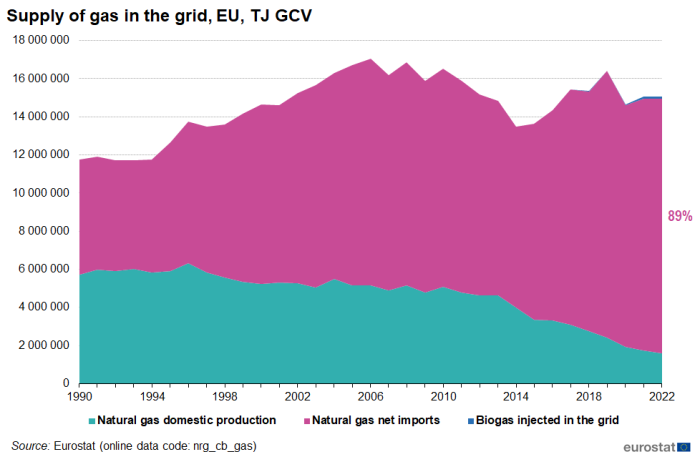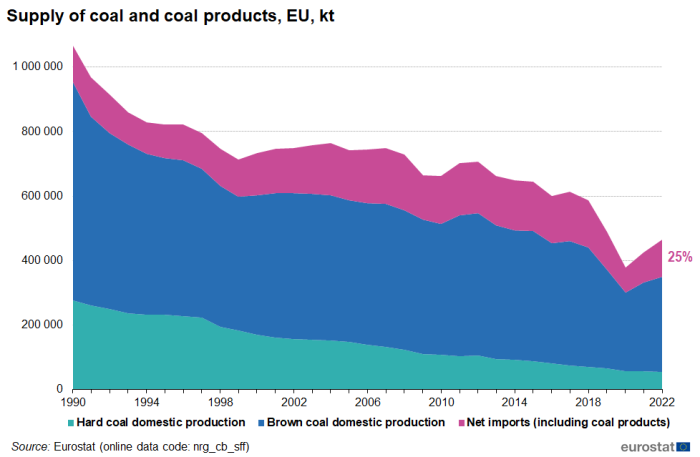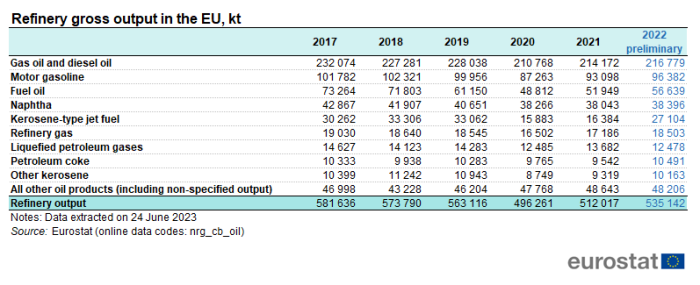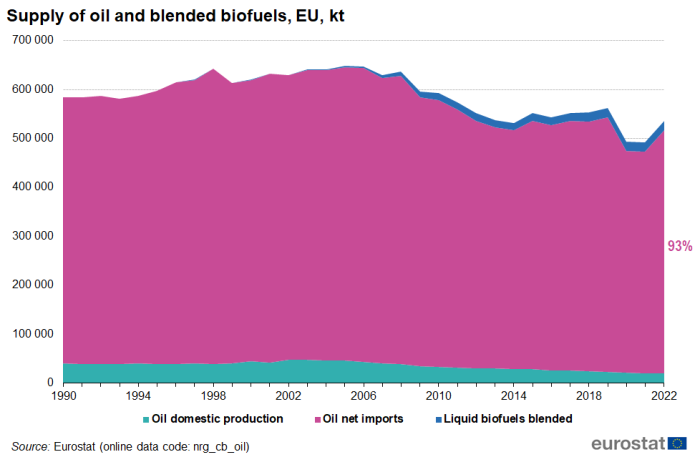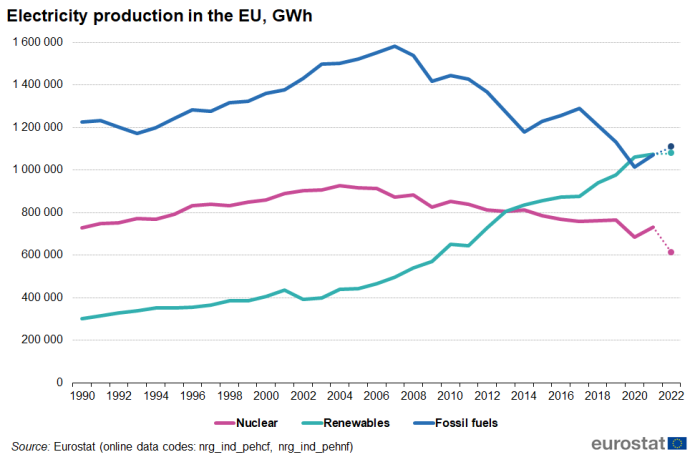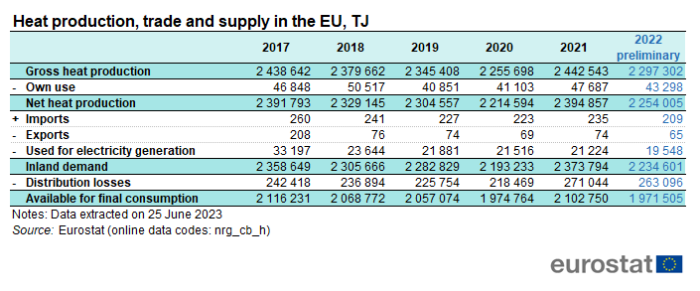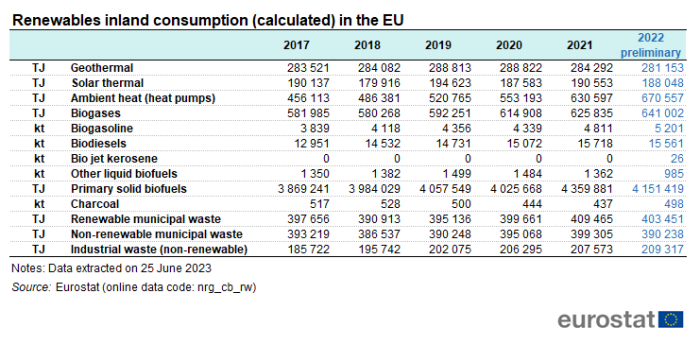Energy production and imports
Data extracted in June 2023.
Planned article update: 28 June 2024.
Highlights
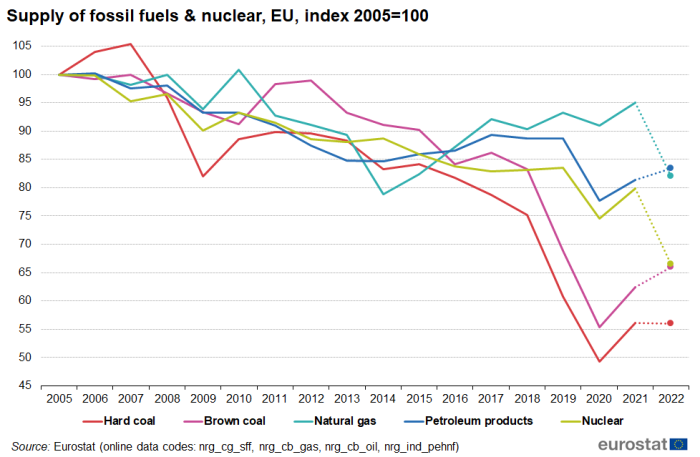
Source: Eurostat (nrg_cb_gas), (nrg_cb_oil), (nrg_cb_gas) and (nrg_ind_pehnf)
After a long period of national lockdowns and restrictive measures introduced to curb the spread of COVID-19 in 2020, many EU Member States experienced a rebound in economic activity in 2021, which further picked up speed in 2022. As businesses reopened and people started to travel again, energy demand increased. In this context and for various reasons, natural gas prices skyrocketed in the second half of 2021, while 2022 was marked by disruptions in gas supply and concerns regarding potential gas shortages. Additionally, the summer of 2022 was exceptionally hot and dry in many EU Member States, affecting nuclear and hydro power generation. All these factors, among others, influenced energy supply and the developments concerning individual energy products.
The figure above shows the indexed supply of fossil fuels and nuclear in the EU in the period 2005 – 2022. After an increase for all products in 2021 compared with 2020, nuclear and natural gas registered a sharp drop in 2022, while brown coal and petroleum products continued increasing. Hard coal was almost on the same level as in 2021, showing only a very slight decrease.
Full article
Natural gas
Preliminary 2022 data indicate a further decrease in the domestic production of natural gas (-8.5 % compared with 2021, -41.5 % compared with 2017-2019). Combined with these production developments, a small increase in net imports (+1.1 %) and a significant stock build resulted in a -13.8 % drop in the inland consumption of natural gas compared with 2021 (see Table 1[1]). Detailed data by country are available in Eurostat's energy database. According to these preliminary country data, the highest decreases in inland consumption of natural gas were registered in Finland (-50.2 %), Sweden (-34.8 %), Lithuania (-28.9 %) and Latvia (-28.2 %). The only EU Member States that reported a higher inland consumption of gas compared with 2021 were Ireland (+2.0 %) and Malta (+1.2 %).
Figure 1 shows the evolution of gas supply in the grid in the period from 1990 until 2022, broken down by natural gas domestic production, net imports, and biogas injected in the grid. It is clear that the EU has increasingly been relying on imports of natural gas, downsizing domestic production. In 2022, net imports made up as much as 89 % of gas supply in the grid. Biogas injected in the grid, although on the rise, still makes up only a very small portion of the total gas supply in the grid and is therefore unlikely to compensate for any natural gas shortages in the near future.
Solid fossil fuels (coal) and manufactured gases
Following a generally downward path for many years, coal consumption took a reverse course in 2021, which continued in 2022. However, it should be noted that in 2020 solid fossil fuels were on a record low level since data are available (i.e. since 1990), partially due to lockdowns introduced during the COVID-19 pandemic. The rise in 2021 was to a large extent caused by the post-lockdown industrial recovery, as well as by the increased use of coal for electricity and heat generation in some EU Member States, as a replacement for the increasingly expensive natural gas. The trend of more coal-generated electricity and heat continued in 2022, provoked additionally by disruptions in gas supply and efforts to reduce gas consumption. However, even with the increasing figures observed in 2022, solid fossil fuels were on their third lowest level since 1990.
Compared with 2021, inland consumption of lignite in the EU increased by 16.1 million tonnes (Mt) (+5.8 %), other bituminous coal rose by 0.9 Mt (+0.7 %), oil shale and oil sands by 1.9 Mt (+14.5 %). On the other hand, coking coal inland consumption decreased by 0.5 Mt (-1.2 %), and coke oven coke by 2.5 Mt (-7.5 %). Manufactured gases, mostly produced in relation to coal consumption in the iron and steel industry, decreased rather significantly, with the exception of gas works gas. Comparing the inland consumption of coal with the pre-COVID-19 pandemic years 2017-2019, we see a very clear decreasing trend for all products, without exception. In comparison with the period 2017-2019, the drop is most notable for gas works gas (-82.7 %), sub-bituminous coal (-59.7 %), peat (-48.3 %) and anthracite (-46.3 %). These data are presented in Table 2[2].
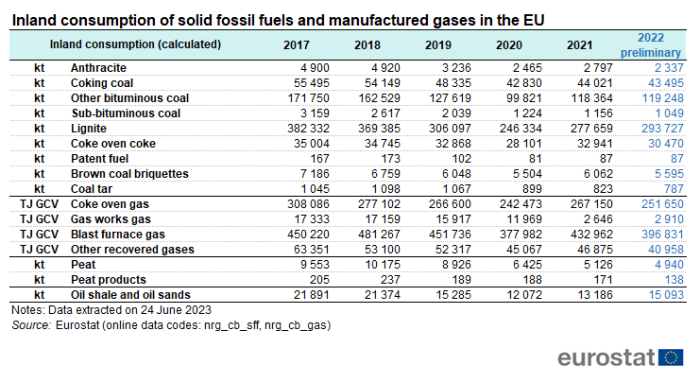
Source: Eurostat (nrg_cb_sff)
Tables 3 and 4 show the supply and trade data for brown coal and hard coal. These two aggregates cover the majority of fuels used. While hard coal supply remained more or less stable compared with 2021 (-0.1 %), this was to a large extent due to an increase in imports (+25.0 %), whereas brown coal inland consumption rose by 5.7 % primarily due to increased domestic production (+7.0 %). Figure 2 shows the development of brown coal and hard coal domestic production and net imports[3] since 1990, indicating a long-term downward trend for both aggregates until 2021, most notably in production.
Oil
Data for 2021 and preliminary 2022 data indicate that the demand of refineries for primary oil (such as crude oil) has unsurprisingly been on the increase after experiencing a sharp drop in 2020. Calculated refinery intake rose by 3.5 % in 2021 compared with the year before, and by 4.0 % in 2022 compared with 2021 (see Table 5). A similar trend (+3.2 % in 2021/2020 and +4.5 % in 2022/2021) was also observed for the supply of refined petroleum products from refineries (see Table 6). However, compared with the period 2017-2019, both refinery intake and output decreased, by 6.3 % and 6.6 % respectively. In 2022, gas oil and diesel oil followed by motor gasoline were the most significant oil products refined in the EU, accounting together for 58.5 % of the total refinery output, down from 60.0 % in 2021.
Gross inland deliveries of all petroleum products to the EU market show an increase in 2022 (+2.4 %) compared with 2021. While gross inland deliveries of some individual products registered a decrease, most of them increased, most notably kerosene-type jet fuel, suggesting that air travel recovered in 2022 almost to pre-COVID-19 pandemic levels.

Source: Eurostat (nrg_cb_oil)
Figure 3 shows the development of the supply of oil and blended biofuels in the period 1990-2022, broken down by domestic production, net imports and biofuels blended. Similarly to natural gas, we can see that domestic production follows a decreasing trend, while any rising demand needs are typically met by increasing imports. However, contrary to gas, the total supply has been slowly decreasing over the years, with the exception of the last two post-COVID-19 pandemic years.
Electricity
The total electricity supply in the EU decreased by 2.8 % compared with 2021, and by 3.3 % compared with the pre-COVID-19 pandemic period 2017-2019. Preliminary data indicate significant annual variations between various fuel sources. After the renewable category for the first time surpassed fossil fuels for electricity generation in 2020, 2021 saw a return to fossil fuel dominance, which continued and intensified in 2022 (see Figure 4). On the renewables side, preliminary 2022 data show the highest increases in electricity produced from solar photovoltaic energy (+29.3 % or 46.5 terawatt hours (TWh)) on the EU level, followed by wind (+8.9 % or 34.4 TWh). On the other hand, due to unfavourable weather conditions, electricity generation from hydro saw a very sharp drop (-17.7 %). There were no significant changes in the production of electricity from natural gas (-1.3 % or -7.1 TWh). At the same time, electricity generation from certain important solid fossil fuels increased in 2022: other bituminous coal (+10.0 % or +18.9 TWh) and lignite (+6.7 % or +15.3 TWh). In comparison with 2021, the output of nuclear power plants decreased significantly, by 16.7 % (-122.5 TWh), as a result of maintenance issues as well as a permanent shut-down of a number of reactors. Nevertheless, on the level of individual fuels, nuclear continued to be the most important contributor to the EU electricity generation system (609 TWh or 21.8 %). It was followed by natural gas (545 TWh or 19.5 %), wind (421 TWh or 15.0 %), hydro (309 TWh or 11.0 %), lignite (241 TWh or 8.6 %), other bituminous coal (209 TWh or 7.5 %) and solar photovoltaic (205 TWh or 7.3 %). Fossil fuels in total (1 108 TWh) were once again the greatest contributor as an individual fuel group, with renewables closely following (1 076 TWh) (Table 7 and Figure 4[4]).

Source: Eurostat (nrg_ind_pehcf) and (nrg_ind_pehnf)
We can see in Table 8 that there have not been any significant developments in terms of trade and that exports are always almost the same as imports. On the level of the EU, trade in electricity serves mostly the purpose of grid balancing. While some countries are net importers, the EU as whole has sufficient electricity generation capacities to meet its electricity demand.
Figure 5 shows the developments in electricity production from nuclear, renewables and fossil fuels in the period 1990-2022. In 2022, fossil fuels were once again the most important fuel group for electricity generation in the EU.
Heat
The total derived heat supply in the EU in 2022 is estimated to have decreased by 6.2 % compared with 2021, and by 5.2 % compared with the period 2017-2019. This refers only to heat that was sold – autoconsumed heat is not reflected in these figures. Natural gas as the most important fuel for heat production in the EU saw a decrease of 11.9 % or 49.9 petajoules (PJ). Solid biofuels, the second largest contributor to heat production, dropped by 8.0 % or 44.1 PJ, whereas heat from other bituminous coal decreased by 4.7 % or 16.3 PJ. Heat from wastes remained at almost the same level as in 2021 (-0.1 %). Other sources contribute significantly less to the total heat production, and preliminary data indicate mixed trends (Table 9).
As shown in Table 10, imports and exports of heat are virtually non-existent in the EU and heat supply relies exclusively on domestic heat production.
Renewables and wastes
Tables 11 and 12 do not feature renewables energies that are used exclusively for electricity generation, such as hydro, wind and solar PV. However, renewables that produce heat (geothermal and solar thermal) are shown, and some of that energy is used also to produce electricity/heat, as indicated in the previous sections.
Preliminary 2022 data indicate different trends for different renewable fuels and wastes. For example, inland consumption of charcoal increased compared with 2021 (+13.9 %), following an increase both in indigenous production and in net imports. Inland consumption of liquid biofuels dropped very slightly (-0.5 %), despite an increase in net imports. A drop in both production and net imports of primary solid biofuels led to a decrease of -4.8 % in consumption, whereas wastes decreased by 1.3 % (see Table 11). If we compare consumption in the period 2017-2019, we see reverse trends for these products: charcoal -3.2 %, liquid biofuels +11.2 %, primary solid biofuels +4.6 %, wastes +2.4 %.
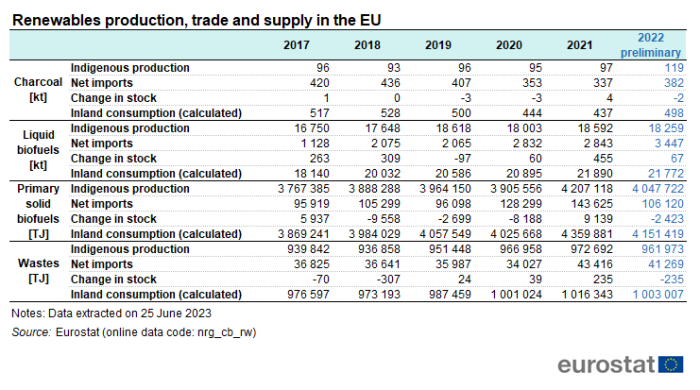
Source: Eurostat (nrg_ind_pehcf) and (nrg_cb_rw)
Table 12 shows the developments for inland consumption of individual products.
Source data for tables and graphs
Data sources and methodology
This article includes final annual data up to 2021 and preliminary 2022 data for energy commodities, focusing on the developments regarding energy production and imports. As 2021 was still to a certain extent affected by COVID-19-related lockdowns, preliminary 2022 data are also compared with the pre-COVID-19 pandemic period 2017-2019. Annual energy data are transmitted to Eurostat in line with Regulation (EC) No 1099/2008 on energy statistics. Final official energy annual data (the European statistics on energy) are published in a harmonised form of commodity/energy balance by Eurostat 12-13 months after the end of the reference period. As of 2018, Eurostat is also publishing preliminary annual supply-side data of the commodity balances, transmitted by countries 5 months after the end of the reference period. Prior to reference year 2022, countries were reporting preliminary annual energy data on a voluntary basis. This reporting is mandatory as of reference year 2022. Data collection (including possible estimation) is done at the national level by the respective National Statistical Institutes or Other National Authorities transmitting data to Eurostat. Eurostat does not publish any estimates for values not transmitted by individual reporting countries. Preliminary data may overestimate categories like "other", "other sources" and "non-specified"; and underestimate certain product groups (for example for electricity and heat generation). Data reported 5 months after the reference year should be considered as preliminary; these are not final data for policy evaluation or official monitoring of developments towards legally binding targets.
Context
Energy Union is one of the main policy instruments to deliver the EU's energy strategy. The first State of the Energy Union report stated the following: "In order to track progress, a transparent monitoring system has to be put in place based on key indicators as well as on Member States' biannual reports concerning progress made on their national plans. The Commission intends to assess collective progress made at the EU level in its annual State of the Energy Union and, if necessary, propose policy actions and measures to ensure the delivery of the Energy Union objectives". Using reliable high quality data to monitor the progress made to achieve EU targets will enhance the credibility of the EU energy policy. Therefore, official statistics need to contribute to this process to remain relevant and aligned to the needs of our policy-makers and society. The energy data presented in this article support this monitoring.
Direct access to
- All articles on energy
- All energy articles in alphabetical order
- Energy (nrg), see:
- Energy statistics - quantities (nrg_quant)
- Energy statistics - quantities, annual data (nrg_quanta)
- Supply, transformation and consumption - commodity balances (nrg_cb)
- Supply, transformation and consumption of solid fossil fuels (nrg_cb_sff)
- Supply, transformation and consumption of gas (nrg_cb_gas)
- Supply, transformation and consumption of oil and petroleum products (nrg_cb_oil)
- Supply, transformation and consumption of renewables and wastes (nrg_cb_rw)
- Supply, transformation and consumption of electricity (nrg_cb_e)
- Supply, transformation and consumption of derived heat (nrg_cb_h)
- Energy indicators (nrg_ind)
- Gross production of electricity and derived heat from combustible fuels by type of plant and operator (nrg_ind_pehcf)
- Gross production of electricity and derived heat from non-combustible fuels by type of plant and operator (nrg_ind_pehnf)
- Supply, transformation and consumption - commodity balances (nrg_cb)
- Energy statistics - quantities, annual data (nrg_quanta)
- Energy statistics - quantities (ESMS metadata file: European and national metadata)
- Supply, transformation and consumption - commodity balances (ESMS metadata file)
- Energy balances (ESMS metadata file)
- Regulation (EC) No 1099/2008 on energy statistics
Visualisations
Notes
- ↑ Natural gas quantities are expressed in Terajoules - Gross Calorific Value (TJ GCV).
- ↑ Solid fossil fuel quantities are expressed in thousand tonnes (kilotons, kt), and quantities of manufactured gases in Terajoules - Gross Calorific Value.
- ↑ Net imports are calculated as the quantity of imports minus the equivalent quantity of exports. Imports represent all entries into the national territory excluding transit quantities; exports similarly cover all quantities exported from the national territory.
- ↑ The unit of measurement used is gigawatt hours (GWh).

